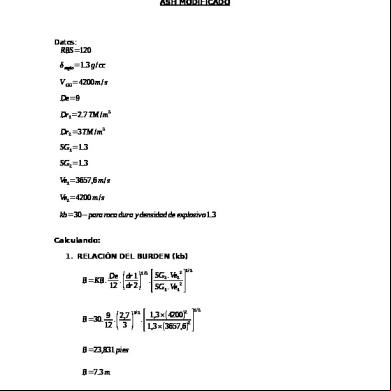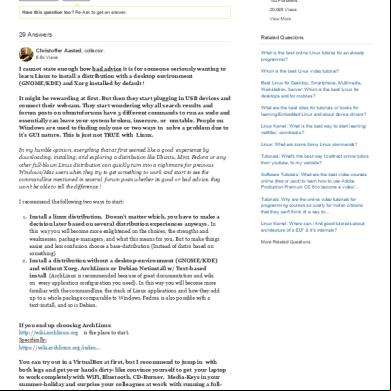Lecture 6 30572g
This document was ed by and they confirmed that they have the permission to share it. If you are author or own the copyright of this book, please report to us by using this report form. Report 3b7i
Overview 3e4r5l
& View Lecture 6 as PDF for free.
More details w3441
- Words: 877
- Pages: 26
Thermodynamics I Lecture 6: Work and Heat Prof: Dr. P.Q. Gauthier
Work
Work is usually defined as a force F acting through a displacement x, the displacement being in the direction of the force. That is: 2
W Fdx 1
Thermodynamics I
Lecture 6
2 Dr. P.Q. Gauthier
Work
In thermodynamics, work is defined as an energy interaction between a system and its surroundings.
A rising piston ,
a rotating shaft
an electric wire crossing the system boundaries are all associated with work interactions
Work has energy units: kJ, kJ/kg
Power has Energy per seconds units: kJ/s =Watts
Thermodynamics I
Lecture 6
3 Dr. P.Q. Gauthier
Work
Work is a directional quantity.
Work done on a system is negative,
Work done by the system is positive
System possess energy, but not work,
Work is associated with a process, not a state
Unlike properties, work has no meaning at a state
Thermodynamics I
Lecture 6
4 Dr. P.Q. Gauthier
Work
Work is a path function
Thermodynamics I
Lecture 6
5 Dr. P.Q. Gauthier
Mechanical Forms of Work
If F is constant
W F*s
If F is not constant
W
Thermodynamics I
2
1
kJ
Fds
Lecture 6
6 Dr. P.Q. Gauthier
Mechanical Forms of Work
Moving Boundary work: This type of work is associated with the expansion or compression of a gas in a piston-cylinder device. This is the primary form of work involved in automobile engines
Thermodynamics I
Lecture 6
7 Dr. P.Q. Gauthier
Quasi-equilibrium process
Quasi-equilibrium process is a process during which the system remains in equilibrium at all times
Figure:
A
differential
gas
does
amount
a of
work δWb as it force the piston
to
move
by
a
differential amount ds
Thermodynamics I
Lecture 6
8 Dr. P.Q. Gauthier
Quasi-equilibrium process
Boundary work in differential form
Wb Fds PAds PdV
The total work done during the entire process 12 is 2
2
1
1
Wb Wb PdV To integrate P=f(V) should be available
Thermodynamics I
Lecture 6
9 Dr. P.Q. Gauthier
Quasi-equilibrium process
Figure: The area under the process curve on a P-V diagram represents the boundary work
Thermodynamics I
Lecture 6
10 Dr. P.Q. Gauthier
Boundary Work during a Constant Volume Process
Example 1: A rigid tank contains air at 500 kPa and 150˚C. As a result of heat transfer to the surroundings, the temperature and pressure inside the tank drop to 65˚C and 400 kPa, respectively. Determine the boundary work done during this process
Thermodynamics I
Lecture 6
11 Dr. P.Q. Gauthier
Boundary Work during a Constant Volume Process
Thermodynamics I
Lecture 6
12 Dr. P.Q. Gauthier
Solution
Thermodynamics I
Lecture 6
13 Dr. P.Q. Gauthier
Boundary Work for a ConstantPressure Process
Example 2: A frictionless piston-cylinder device contains 10lbm of steam at 60 psia and 320˚F. Heat is now transferred to the steam until the temperature reaches 400˚F. If the piston is not attached to a shaft and its mass is constant, determine the work done by the steam during this process
Thermodynamics I
Lecture 6
14 Dr. P.Q. Gauthier
Example 2
Thermodynamics I
Lecture 6
15 Dr. P.Q. Gauthier
Solution
Thermodynamics I
Lecture 6
16 Dr. P.Q. Gauthier
Solution
Thermodynamics I
Lecture 6
17 Dr. P.Q. Gauthier
Polytropic Process
During expansion and compression processes of real gases, n
pressure and volume are often related by PV = C, where n and C are constants. A process of this kind is called a polytropic process
Thermodynamics I
Lecture 6
18 Dr. P.Q. Gauthier
Boundary Work during Isothermal Process
Example: A piston cylinder device initially contains 0.4 m 3 of air at 100 kPa and 80°C. The air is now compressed to 0.1 m 3 in such a way that the temperature inside the cylinder remains constant. Determine the work done during this process
Thermodynamics I
Lecture 6
19 Dr. P.Q. Gauthier
Polytropic Process
Thermodynamics I
Lecture 6
20 Dr. P.Q. Gauthier
Solution
Thermodynamics I
Lecture 6
21 Dr. P.Q. Gauthier
Polytropic Process
Figure: Schematic of P-v diagram for a polytropic process
Thermodynamics I
Lecture 6
22 Dr. P.Q. Gauthier
Polytropic Process
Wb for a polytropic process
Wb
2
1
PdV
2
1
n 1 n 1 2 V V C n 2 1 dV C V dV C 1 n 1 Vn
n 1 n CV21n CV11n P2V2nV21n PV V P2V2 PV 1 1 1 1 1 1 n 1 n 1 n
For an ideal gas PV=nRT, thus P2V2 PV mR(T2 T1 ) 1 1 Wb for n 1 1 n 1 n Thermodynamics I
Lecture 6
23 Dr. P.Q. Gauthier
Problem
Argon is compressed in a polytropic process with n= 1.2 from 120 kPa and 30C to 1200 kPa in a piston cylinder device. Determine the work produced and heat transferred during this compression process, in kJ/kg
Thermodynamics I
Lecture 6
24 Dr. P.Q. Gauthier
Solution
Thermodynamics I
Lecture 6
25 Dr. P.Q. Gauthier
Solution
Thermodynamics I
Lecture 6
26 Dr. P.Q. Gauthier
Work
Work is usually defined as a force F acting through a displacement x, the displacement being in the direction of the force. That is: 2
W Fdx 1
Thermodynamics I
Lecture 6
2 Dr. P.Q. Gauthier
Work
In thermodynamics, work is defined as an energy interaction between a system and its surroundings.
A rising piston ,
a rotating shaft
an electric wire crossing the system boundaries are all associated with work interactions
Work has energy units: kJ, kJ/kg
Power has Energy per seconds units: kJ/s =Watts
Thermodynamics I
Lecture 6
3 Dr. P.Q. Gauthier
Work
Work is a directional quantity.
Work done on a system is negative,
Work done by the system is positive
System possess energy, but not work,
Work is associated with a process, not a state
Unlike properties, work has no meaning at a state
Thermodynamics I
Lecture 6
4 Dr. P.Q. Gauthier
Work
Work is a path function
Thermodynamics I
Lecture 6
5 Dr. P.Q. Gauthier
Mechanical Forms of Work
If F is constant
W F*s
If F is not constant
W
Thermodynamics I
2
1
kJ
Fds
Lecture 6
6 Dr. P.Q. Gauthier
Mechanical Forms of Work
Moving Boundary work: This type of work is associated with the expansion or compression of a gas in a piston-cylinder device. This is the primary form of work involved in automobile engines
Thermodynamics I
Lecture 6
7 Dr. P.Q. Gauthier
Quasi-equilibrium process
Quasi-equilibrium process is a process during which the system remains in equilibrium at all times
Figure:
A
differential
gas
does
amount
a of
work δWb as it force the piston
to
move
by
a
differential amount ds
Thermodynamics I
Lecture 6
8 Dr. P.Q. Gauthier
Quasi-equilibrium process
Boundary work in differential form
Wb Fds PAds PdV
The total work done during the entire process 12 is 2
2
1
1
Wb Wb PdV To integrate P=f(V) should be available
Thermodynamics I
Lecture 6
9 Dr. P.Q. Gauthier
Quasi-equilibrium process
Figure: The area under the process curve on a P-V diagram represents the boundary work
Thermodynamics I
Lecture 6
10 Dr. P.Q. Gauthier
Boundary Work during a Constant Volume Process
Example 1: A rigid tank contains air at 500 kPa and 150˚C. As a result of heat transfer to the surroundings, the temperature and pressure inside the tank drop to 65˚C and 400 kPa, respectively. Determine the boundary work done during this process
Thermodynamics I
Lecture 6
11 Dr. P.Q. Gauthier
Boundary Work during a Constant Volume Process
Thermodynamics I
Lecture 6
12 Dr. P.Q. Gauthier
Solution
Thermodynamics I
Lecture 6
13 Dr. P.Q. Gauthier
Boundary Work for a ConstantPressure Process
Example 2: A frictionless piston-cylinder device contains 10lbm of steam at 60 psia and 320˚F. Heat is now transferred to the steam until the temperature reaches 400˚F. If the piston is not attached to a shaft and its mass is constant, determine the work done by the steam during this process
Thermodynamics I
Lecture 6
14 Dr. P.Q. Gauthier
Example 2
Thermodynamics I
Lecture 6
15 Dr. P.Q. Gauthier
Solution
Thermodynamics I
Lecture 6
16 Dr. P.Q. Gauthier
Solution
Thermodynamics I
Lecture 6
17 Dr. P.Q. Gauthier
Polytropic Process
During expansion and compression processes of real gases, n
pressure and volume are often related by PV = C, where n and C are constants. A process of this kind is called a polytropic process
Thermodynamics I
Lecture 6
18 Dr. P.Q. Gauthier
Boundary Work during Isothermal Process
Example: A piston cylinder device initially contains 0.4 m 3 of air at 100 kPa and 80°C. The air is now compressed to 0.1 m 3 in such a way that the temperature inside the cylinder remains constant. Determine the work done during this process
Thermodynamics I
Lecture 6
19 Dr. P.Q. Gauthier
Polytropic Process
Thermodynamics I
Lecture 6
20 Dr. P.Q. Gauthier
Solution
Thermodynamics I
Lecture 6
21 Dr. P.Q. Gauthier
Polytropic Process
Figure: Schematic of P-v diagram for a polytropic process
Thermodynamics I
Lecture 6
22 Dr. P.Q. Gauthier
Polytropic Process
Wb for a polytropic process
Wb
2
1
PdV
2
1
n 1 n 1 2 V V C n 2 1 dV C V dV C 1 n 1 Vn
n 1 n CV21n CV11n P2V2nV21n PV V P2V2 PV 1 1 1 1 1 1 n 1 n 1 n
For an ideal gas PV=nRT, thus P2V2 PV mR(T2 T1 ) 1 1 Wb for n 1 1 n 1 n Thermodynamics I
Lecture 6
23 Dr. P.Q. Gauthier
Problem
Argon is compressed in a polytropic process with n= 1.2 from 120 kPa and 30C to 1200 kPa in a piston cylinder device. Determine the work produced and heat transferred during this compression process, in kJ/kg
Thermodynamics I
Lecture 6
24 Dr. P.Q. Gauthier
Solution
Thermodynamics I
Lecture 6
25 Dr. P.Q. Gauthier
Solution
Thermodynamics I
Lecture 6
26 Dr. P.Q. Gauthier











